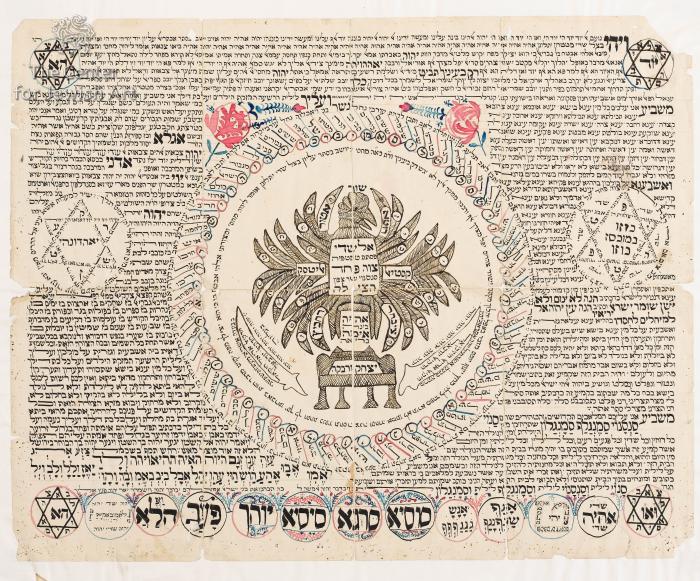Obj. ID: 50549 Amulet, Kurdistan, circa 1900

sub-set tree:
D | Diagram
F | Flower
O | Ornamentation: | Shaped text
A | Angel , (Sandalfon (angel)), (Metatron (angel))
I | Instruments and Tools | Knife
S | Sword
|
The following description was prepared by William Gross:
Birth amulets come in a wide variety of shapes, content, and materials. One custom revolves around the placing of four amulets on each of the walls of the room of mother and child after birth. There are examples in the Gross Family Collection from Morocco, Jerusalem, Ukraine, and in the present case, Iraqi Kurdistan.
This is a larger-than-normal size birth amulet in a singular manuscript form. This is one of the more elaborate handwritten and painted amulets seen. The lengthy text is very unusual and the large image in the center image of a protective angel in which amulet "names" are inscribed. This is based on the printed images of a page, sometimes printed with a Shiviti, and is an image that in the first decades of the 20th century became the iconic image for printed amulets from Jerusalem. In those examples, the angel figure was accompanied by a sketch of the Kabbalistic hand
There are several versions of the present amulet known from different hands, all slightly different from the other. Two such versions exist in the Gross Family Collection. There also exists a short amulet manuscript that gives instructions for how to write this talisman.
This amulet was created to protect pregnant women against infertility and miscarriage as well as to shield newborn male children on the eve of their circumcisions, from the machinations of the evil demon Lilith. Depicted in the center is a fierce multi-winged angel armed with two knives to defend against Lilith. The central image is surrounded by multiple texts calling upon the help of numerous angels and providing further measures of protective security. In the Gross collection, there are also another two amulets of this design from a set of four, 027.011.722 and 027.011.749. This unusual amulet is also closely related to one in the Judah L. Magnes Museum



